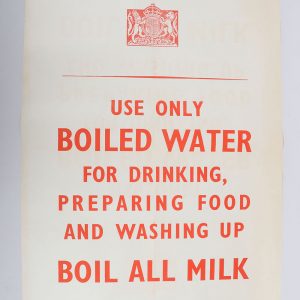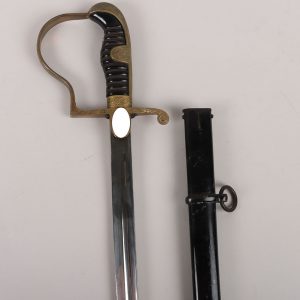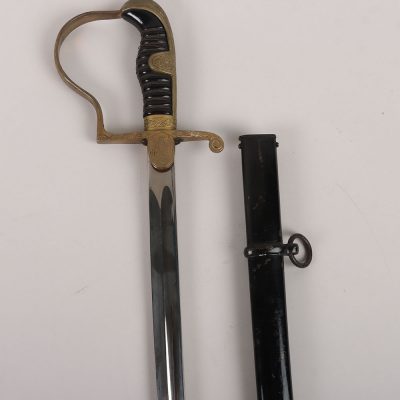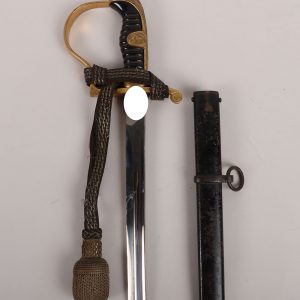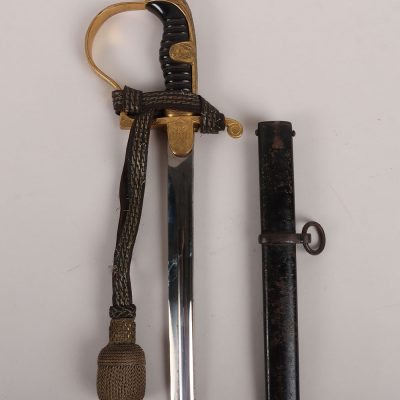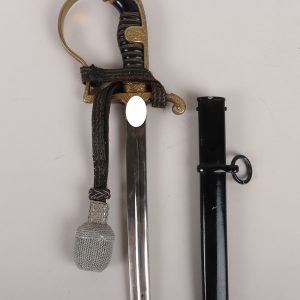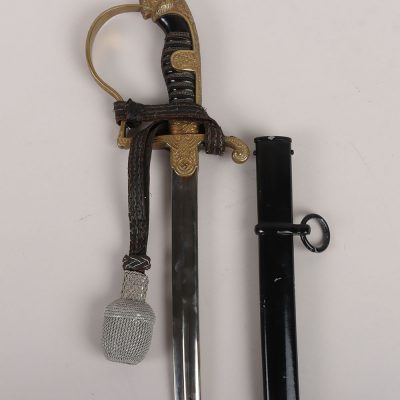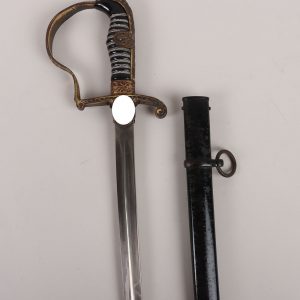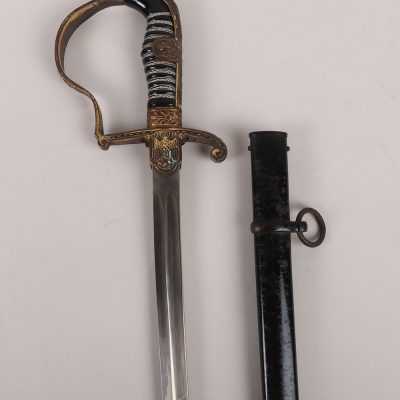Цены, указанные на сайте, могут быть изменены.
Для уточнения актуальных цен свяжитесь с нами или воспользуйтесь формой обратной связи.
Отображение 2145–2160 из 3607
Фильтры-
#339 – WW2 GERMAN ARMY OFFICERS DRESS DAGGER BY ALCOSA, SOLINGEN (Лот: 7691)
Ставки принимаются через менеджераWW2 GERMAN ARMY OFFICERS DRESS DAGGER BY ALCOSA, SOLINGEN, untouched example with dark patina to the exterior fittings. Orange celluloid grip. Housed in its original scabbard. Very good condition blade with much of the original finish and makers trademark to the reverse. Generally good example.
-
#339 – Accoutrements Tin of Lieutenant Colonel C V C Hobart, First Commanding Officer of the 8th Battalion (Princess Beatrice’s Isle of Wight Rifles) Hampshire Regiment Territorial Force (Лот: 6242)
Ставки принимаются через менеджераAccoutrements Tin of Lieutenant Colonel C V C Hobart, First Commanding Officer of the 8th Battalion (Princess Beatrice’s Isle of Wight Rifles) Hampshire Regiment Territorial Force, the japanned storage tin with brass name plaque to the lid ‘Lt Col C. V. C. Hobart 8th Bn Hampshire Regt’. Inside the tin is a pair of officers gloves, three regimental cap badges, pair of plated spurs, tunic medal ribbons and regimental ribbons etc. The DSO register gives the following details, ‘HOBART, CLAUD VERE CAVENDISH, Lieutenant, was born 12 March 1870, only son of Sir Robert Henry Hobart, Baronet, KCVO, CB, Official Verderer of the New Forest, of Langdown, Hants, and of the Honourable Julia Trollope, eldest daughter of the first Baron Kesteven. He was educated at Eton and Sandhurst, and entered the Grenadier Guards 16 July 1890. Lieutenant Hobart, after serving nearly seven years in the Grenadier Guards, was in 1897 seconded for service in the Uganda Protectorate, at that time under the administration of the Foreign Office, and joined the Protectorate Forces, consisting chiefly of Sudanese, who had previously served under Emin Pasha at Wadelai, whilst on a punitive expedition in the Nandi country. Order having been restored, he was detailed to march two companies of Sudanese back to Headquarters at Kampala. On the way he received news of the disaffection of Mwanga, the native King of Uganda, who had raised the standard of revolt in Buddu, one of the southern provinces of his kingdom. He hastened on to the capital, and was thence despatched with his men in a fleet of canoes down the west coast of Victoria Nyanza to occupy and hold the crossing over the Katonga River, separating Buddu from the rest of Uganda, whilst the main forces of the Protectorate under Colonel T P B Ternan, DSO, moved down overland. He successfully carried out his instructions, and the rebels were subsequently defeated in two engagements, at which he was present, which resulted in King Mwanga fleeing into German territory and the bulk of his followers dispersing into the wilds of Ankole. Lieutenant Hobart was left in charge of the reconquered province with two and a half companies of Sudanese. These remained loyal during the subsequent mutiny of portion of the same force in the eastern part of the Protectorate, and though hard pressed at one time, he succeeded in holding his own against the Baganda rebels, who collected again on the news of the mutiny, being joined by the ex-King Mwanga, who contrived to escape from German custody. After several expeditions had been organized against them, in all of which he took part, he was fortunately enabled, whilst in command of an advanced guard composed of Baganda levies, to come up to and inflict a decisive blow on King Mwanga’s main forces at Kisalera. Mwanga’s ally, the rebel King of Koki, was killed, and Mwanga himself barely escaped, only to be captured a few months later in the north of the Protectorate with the remnants of the Sudanese mutineers, who were finally defeated with the assistance of a native regiment from India.For his services during the above operations he was mentioned in Despatches, and also in Parliament, and received the Uganda Medal and clasp. He was also created a Companion of the Distinguished Service Order [London Gazette, 20 May 1898]: “Claud Vere Cavendish Hobart, Lieutenant, Grenadier Guards. In recognition of the, services during the recent operations in Uganda”. On the outbreak of the South African War in 1899, Captain Hobart had just returned to England, and was sent out with the first contingent of troops to the Cape to act as Staff Officer on the Midland Line of Communications. In this capacity he assisted in raising several corps of local volunteers, by whom the Midland Line of railway from Port Elizabeth to Naauwpoort was seized and garrisoned; but falling a victim to a severe attack of enteric fever, he was invalided home in the summer of 1900, subsequently receiving the Queen’s South African Medal with clasp for Cape Colony. In 1902 Captain Hobart officiated as a Gold Staff Officer at the Coronation of King Edward VII and Queen Alexandra, and was also in charge of Apolo Kagwa, the native Prime Minister and Regent of Uganda, who came over to attend the ceremony, and for whom he interpreted on the occasion of his being granted an audience by King Edward. In December 1906, Major Hobart retired from the Regular Army, and was placed on the Reserve of Officers; but in 1908, on the inauguration of the Territorial Force, he was appointed Lieutenant Colonel Commanding Princess Beatrice’s Isle of Wight Rifles (8th Battalion The Hampshire Regiment), which he raised and reorganized from a small volunteer nucleus and commanded till 1913, when he retired. He again acted as Gold Staff Officer at a Coronation—that of King George V and Queen Mary, in 1911. On the European War breaking out in 1914, Lieutenant Colonel Hobart, after serving for short periods on the Embarkation Staff at Southampton and the Military Landing Staff at Havre, was sent to the front in Flanders as a Railhead Commandant, being subsequently appointed Administrative Commandant of the railheads of an army. He was mentioned in Despatches in 1916 and 1918, and received the 1914 Star. Lieutenant Colonel C V C Hobart married, on 10 December 1900, at St Peter’s, Eaton Square, London, Violet Verve, second daughter of John Wylie, of West Cliff Hall, Hants, and they had one son, Robert Hampden, born 7 May 1915. Late Rod Flood collection. Provenance Christies 1st February 1991, Lot 107.
-
#339 – WW2 British Home Front Poster ‘PORTS ARE OFTEN BOMBED WHEN CONVOYS ARE IN BECAUSE SOMEONE TALKED’ (Лот: 8931)
Ставки принимаются через менеджераWW2 British Home Front Poster ‘PORTS ARE OFTEN BOMBED WHEN CONVOYS ARE IN BECAUSE SOMEONE TALKED’, small rectangular printed poster showing fireman putting out fires in a port with enemy aircraft above, slogan below ‘PORTS ARE OFTEN BOMBED WHEN CONVOYS ARE IN BECAUSE SOMEONE TALKED – Never mention arrivals, sailings, cargoes or destinations to anybody’. Printers details to the bottom corner. Measures 34 x 50 ½ cms.
-
#340 – WW2 GERMAN ARMY OFFICERS DRESS DAGGER BY CARL EICKHORN, SOLINGEN (Лот: 7692)
Ставки принимаются через менеджераWW2 GERMAN ARMY OFFICERS DRESS DAGGER BY CARL EICKHORN, SOLINGEN, good example with orange celluloid grip, nice dark patina to the fittings. Housed in its original scabbard. Double edged blade with much of the original polish remaining. Makers trademark to the reverse. Good example overall.
-
#340 – Unusual Victorian / WW1 Indian Army Water Bottle (Лот: 6243)
Ставки принимаются через менеджераUnusual Victorian / WW1 Indian Army Water Bottle, khaki cloth covered aluminium water bottle with cork stopper and thick khaki cloth shoulder strap. Unmarked. Worn by Indian Army troops in the later stages of the Victorian era and into the WW1 period including campaigns such as the Gallipoli campaign.
-
#340 – British Home Front Poster, Lend A Hand On The Land (Лот: 8932)
Ставки принимаются через менеджераBritish Home Front Poster, Lend A Hand On The Land, printed by the Fosh & Cross Ltd. Poster shows black and white artist illustration of people going about their daily business and underneath is colour patriotic image of people working on the farms. Poster remains in good overall condition. Measures 37 ½ x 50 ½ cms.
-
#341 – THIRD REICH SA (STURMABTEILUNG) DRESS DAGGER BY CHRISTIANWERK, SOLINGEN (Лот: 7693)
Ставки принимаются через менеджераTHIRD REICH SA (STURMABTEILUNG) DRESS DAGGER BY CHRISTIANWERK, SOLINGEN, good untouched example with good condition wooden grip, nickel silver eagle and enamel SA device. Lower cross guard mount stamped ‘Nrh’. Housed in its anodised scabbard with a fine brown leather three piece hanger is attached. Good condition blade with standard motto ‘Alles fur Deutschland’ and makers trademark to the reverse.
-
#341 – WW2 1943 ENSA Concert Poster for George Formby (Лот: 8933)
Ставки принимаются через менеджераWW2 1943 ENSA Concert Poster for George Formby, fine printed poster for a concert by legendry entertainer, George Formby, when he appeared at the Britannia Club on 27th September 1943. Printed with ENSA details. Remains in good condition overall. Measures 31 ½ x 48cms.
-
#342 – WW2 GERMAN K98 DRESS BAYONET WITH ENGRAVED BLADE BY WKC (Лот: 7694)
Ставки принимаются через менеджераWW2 GERMAN K98 DRESS BAYONET WITH ENGRAVED BLADE BY WKC, good example of a parade pattern bayonet with two piece chequered grips, plated eagle head pommel with red felt to the interior of the slot. Housed in its original scabbard with much of the black finish remaining. Nice polished blade with etched memory of my service dedication and eagle to the centre. WKC makers trademark. Removable leather washer still in place. Generally good example.
-
#342 – WW1 British 1914 Pattern Pistol Ammunition Pouch (Лот: 6245)
Ставки принимаются через менеджераWW1 British 1914 Pattern Pistol Ammunition Pouch, fine example of the hard to find pistol ammunition pouch for the 1914 pattern leather equipment, with one strap having makers stamp and 1915 date, makers stamp not clear. Some cracking to the leather but generally still a good example.
